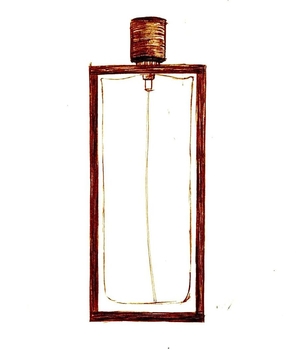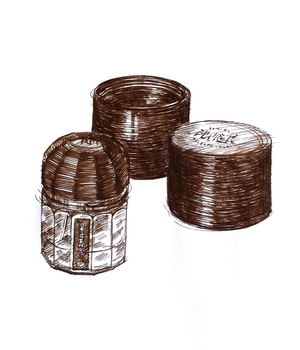Article Archive
Guerlain
Derby
21 August, 2015
 What a great perfume this is. Rich and complex yet totally wearable, Derby smells of old-fashioned luxury and style. It’s the kind of perfume that should have been name-checked in The Great Gatsby (surely the worst-written major novel of the 20th century), and yet it was first launched as recently as 1985, when electropop ruled the airwaves and shoulder-pads the size of aircraft carriers filled the pages of the fashion magazines.
What a great perfume this is. Rich and complex yet totally wearable, Derby smells of old-fashioned luxury and style. It’s the kind of perfume that should have been name-checked in The Great Gatsby (surely the worst-written major novel of the 20th century), and yet it was first launched as recently as 1985, when electropop ruled the airwaves and shoulder-pads the size of aircraft carriers filled the pages of the fashion magazines.
It was created by Jean-Paul Guerlain, the last member of the family to run the brand and a great perfumer in his own right: his other triumphs include Habit Rouge, Chamade and the fantastic Vétiver. Derby smells like crushed aromatic herbs when you first spray it on: rosemary and lavender with a hint of mint, but mixed with more exotic things like patchouli and sandalwood. Mace and pepper add a tiny touch of spice, while oakmoss, leather and vetiver give it extra depth and staying-power. After a while it smells more leathery than anything else, though still with herbs and spices mixed in – the scent of a Greek mountainside in summer.
For a long time Derby was quite hard to track down, which added to its mystique, but in 2005 Guerlain relaunched it as part of its Parisiens collection, at which point is was probably (though of course perfume companies never tell you these things) slightly ‘tweaked’ to change some of its ingredients (such as oakmoss) to comply with EU legislation. In 2011 it was repackaged in what I think is a rather cheap-looking balsawood frame, and its price went up as well: today it’s one of Guerlain’s most expensive fragrances, which I think is a shame, as it deserves to be widely worn.
Ramón Monegal
Dry Wood
2 March, 2015
 The world of perfume is full of great stories – some of them true, others completely bogus or quietly tweaked by fiendish marketeers. The story of Ramón Monegal is one of the better ones, and it’s also more interesting than most. The nice thing is that it has a happy ending too.
The world of perfume is full of great stories – some of them true, others completely bogus or quietly tweaked by fiendish marketeers. The story of Ramón Monegal is one of the better ones, and it’s also more interesting than most. The nice thing is that it has a happy ending too.
Monegal’s great-grandfather founded Myrurgia, which during the twentieth century became the best-known perfume brand in Spain. Ramón joined the business in 1972, training at Firmenich in Geneva and in Paris with the famous perfumer Pierre Bourdon (creator of Davidoff’s Cool Water and Serge Lutens’ Feminité du Bois).
Ramón created his first perfume for Myrurgia in 1979, but he also went on to develop scents for other brands, from Adolfo Dominguez to Inès de la Fressange. He eventually became vice-president of the family company, but in 2000 it was sold to Puig, the giant Barcelona-based fragrance-and-fashion group, which owns everything from Jean-Paul Gaultier to Penhaligon’s and L’Artisan Parfumeur.
The transition from owner to employee is surely always a difficult one, and though Monegal was appointed development director for the group’s fragrance brands, it must have hurt when, in 2007, Puig closed Myrurgia down. Monegal left the same year, but in 2010 he launched his own brand, and in 2014 he made a remarkable comeback by releasing fourteen new fragrances in one go. All the ones I’ve smelled so far are interesting and unusual, and Dry Wood is no exception.
It’s been described as a ‘sharp sandalwood’, but it also reminds me of a top-quality men’s aftershave from the 1970s, with hints of cedar and pine as well as sandalwood; if you remember the old ‘things happen after a Badedas bath’ adverts you’ll know the kind of thing I mean. It has great staying-power, and after a while smells woodier than it does to start with, though still with a touch of pine and turpentine.
Like all the perfumes in the range, Dry Wood comes in attractively luxurious packaging, also designed by Monegal. The chunky twelve-sided ‘inkwell’ bottles, with their flip-up black domed caps, are apparently inspired by his love of literature, and are contained in black Bakelite tubes, which screw closed in a very satisfying way. Perhaps it’s not surprising that these perfumes are expensive, at £130 for just 50ml (or $160 in the States).
The only problem at the moment is buying them: currently they’re only available from Harrods in the UK or Nieman Marcus in the US, which means they’re not going to get as wide an exposure as I think they deserve. Still, they’re well worth tracking down if you have the dedication (and the cash).
Cartier
Déclaration d’un Soir
18 February, 2015
 ‘This new masculine scent sensation is perfect for grand evenings – an impulsive perfume capable of sweeping away taboos, brazenly daring to say the unsayable and conjuring up moments of unforgettable bliss. Like a magic wand, it unleashes the emotions and feelings…’
‘This new masculine scent sensation is perfect for grand evenings – an impulsive perfume capable of sweeping away taboos, brazenly daring to say the unsayable and conjuring up moments of unforgettable bliss. Like a magic wand, it unleashes the emotions and feelings…’
Yes, it’s perfume bollocks time again, though at least this time at least it’s for rather a nice scent: Cartier’s Déclaration d’un Soir. Launched in 2012, it was created by their in-house perfumer, Mathilde Laurent, and like Cartier’s earlier (and now quietly discontinued) Must de Cartier Pour Homme, it has a surprising amount of rose in it for a men’s fragrance.
But don’t let that put you off: just as there’s no reason (in the right context) that a man can’t wear pink, so there’s no reason that the scent of rose, if it’s mixed with the right ingredients, has to smell floral and girly. That’s the brilliant trick of Serge Lutens’ Féminité du Bois, which – figuratively speaking – puts the smell of rose in a rather masculine cedar box.
Déclaration d’un Soir isn’t as striking as Feminité du Bois, but it’s got an appealingly plush feeling, with a slight (and not unpleasant) hint of damp soil. Déclaration d’un Soir does have a woody side to it, too, but in this case Mathilde Laurent has used sandalwood, which adds its own sweet spiciness to nutmeg, cumin and pepper.
(Incidentally, what is it about recent men’s perfumes and pepper? Virtually every ‘mainstream’ scent I’ve smelled in the last few years has reeks of the stuff, as if some secret society had ordained that all men’s perfumes had to include masses of pepper. I guess it’s just a fashion, but it makes most of them smell about as subtle and appealing as a pepper spray or a short-circuited computer. Luckily the pepper in Déclaration d’un Soir is pretty restrained.)
It’s a nice scent, as I say: warm, rich, long-lasting and – to my mind anyway – completely unisex. The only shame is that it comes in such a fussily designed bottle (the same as Cartier’s best-selling Déclaration), with its silly clip to stop you depressing the spray-top instead of a cap.
Far more of a shame, though, is the fact that Cartier have given up on Must de Cartier Pour Homme, which I liked even more and which came in that rarest thing: a really beautifully designed bottle. But that’s the perfume industry for you: a triumph of economics over aesthetics.
Christian Dior
Dior Homme
19 May, 2014
 We all have blind spots, and Dior Homme has definitely been one of mine. I was, very kindly, given a bottle some time ago, and I admired its clear glass-and-lucite design, but as for the perfume inside – I just didn’t get it. It had excellent reviews, and it obviously sells well, so I thought I’d better give it another try.
We all have blind spots, and Dior Homme has definitely been one of mine. I was, very kindly, given a bottle some time ago, and I admired its clear glass-and-lucite design, but as for the perfume inside – I just didn’t get it. It had excellent reviews, and it obviously sells well, so I thought I’d better give it another try.
Still no luck, I’m afraid. It’s not horrible (which is a rarer attribute than you might expect), but neither does it make me go ‘WOW!’, which is the response I’m always hoping for. There’s a hint of something in it that I really don’t like, which it shares with a lot of other men’s fragrances today – a slightly metallic, chemical smell, which might come from dihydromyrcenol or perhaps from ISO E Super, both (ab)used with gay abandon by contemporary perfumers.
So why the brilliant reviews? Am I just completely missing something? Actually, I suspect not. Although it was only launched in 2005, it seems that the original scent might well have been tinkered with and reformulated (quite possibly more than once), meaning that the bottle I have probably smells very little like the much-admired original. Which is a shame, as it did sound very appealing, not least because it was created by the talented Olivier Polge, son of Chanel’s legendary in-house perfumer Jacques Polge.
Whatever the truth of the matter, the version I have and the original do seem to share at least one interesting quality. I’ve pointed out before that in itself perfume is genderless – how can a liquid be ‘masculine’ or ‘feminine’? But there are definitely some ingredients and effects that, at least historically, have been more closely associated with women or men. Vetiver, for example, is considered a classic ‘male’ smell, while iris is widely regarded as and ‘feminine’ and ‘floral’ (even though the scent is extracted not from iris flowers but from its roots).
As its name far from subtly suggests, Dior Homme is aimed squarely at men, yet its main smell, even in my rather synthetic-smelling version, derives from iris; compare it with Chanel’s superlative 1932 and you’ll see what I mean. Either this shows that contemporary men are more sophisticated than some might say, or they’re dumb enough to believe anything they’re sold. I like to think the former, but maybe I’m deluding myself; what do you think?